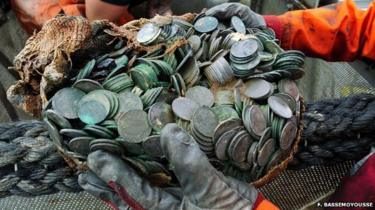
Posted on 04/15/2015 7:38:36 PM PDT by Citizen Zed
The SS City of Cairo was torpedoed 772km south of St Helena by a German U-boat and sank to 5,150m.
The 100 tonnes of coins, recovered in the deepest salvage operation in history, belonged to HM Treasury.
The silver rupees had been called in by London to help fund the war effort.
But they never made it. The steamship's tall plume of smoke was spotted by a U-boat on 6 November 1942 and it was torpedoed.
Ten minutes later, amid efforts to abandon ship, the City of Cairo was hit with a second torpedo which sealed its fate.
The ship and its cargo was presumed lost until 2011, when a team led by British salvage expert John Kingsford located an unnatural object among the ridges and canyons of their South Atlantic search area.
Under a contract with the UK government, underwater salvagers Deep Ocean Search worked for several weeks searching a "jumbled up sea floor" twice the size of London, Mr Kingsford told the BBC.
"We weren't convinced at first," he said. "But you have to give your team their head if they say they've found something, so we looked."
The object was indeed the City of Cairo, and the team recovered a "large percentage" of its £34 million treasure chest. "There was a lot a relief all round," Mr Kingsford said.
The coins have now been melted down in the UK and sold, with the undisclosed sum divided between the treasury - which technically owns the coins - and the salvagers, who take a percentage of the sale.
The salvage was completed in September 2013, but DOS has only now been given permission by the Ministry of Transport to announce it.
As well as the coins, the team brought up the propeller belonging to the second, fatal torpedo.
(Excerpt) Read more at bbc.com ...


Why did they melt them down? Wouldn’t they have gotten more for the coins’ numismatic value?
Silver coins would be pretty degraded after being in salt water all those decades.
Easier to trace/account for exact coins.
Melting leaves room for the “Angel’s Share”.
That many coins would have diluted the value of oldish silver coins on the market.
Amazing how much treasury over the last 500 years was sent in cargo that sank. I guess Europe had 10 year hurricane-free seasons in the Atlantic that lulled them into confidence to keep shipping stuff. But Lloyd’s of London was there to pay the claims.
If the coins were from 1901 (and that was only one sample date) they were probably pretty well circulated when they were gathered before shipping. Non-excellent condition silver coins rarely fetch more than their melt value anyway and they don’t fare very well under salt water. (Unlike gold coins which don’t care) Because the great majority of silver coins will have some copper in them in order to toughen them up, that copper will green up and the coin(s) really can’t be made into much of anything without abrasively cleaning them, and then they are glud. So there really isn’t a good road to achieving any numismatic value. They are unfortunately just junk silver and pretty junky silver at that. They are only 50% silver, unlike US silver coins @ 90% or Cana coins which are 80% or in some cases 92.5%. I am sure a handful of coins might have been saved.
That’s a heck of a deep salvage op.
Very cool!
The Spanish “pieces of eight” come to mind and some of those are in pretty good shape after hundreds of years on the seabed. Maybe the numismatic value of the coins in this case was not there.
***They are unfortunately just junk silver and pretty junky silver at that.***
Yet, some enterprising person will buy the junk silver at junk prices then resell them through periodicals and magazines as “GENUINE SILVER HORDE FORM THE OCEAN FLOOR!”
and make a killing in the amateur coin market for people who don’t know squat about the real value of the coins.
Come on. Everybody knows that Dirk Pitt & Al Giordino were actually the ones who found and brought up the treasure.
Good on ‘em, if they can. A magazine ad like the ones you reference can be well into 5 figures and you probably can’t run just one of them. It takes a lot of selling coins with under $3 of Ag in them for $29.95 to buy such ads. But there are people who can market such things feasibly. I’m not one of them. I suspect Americans would buy “Gold Rush” gold coins a bit faster than they would buy Indian Rupees. I used to collect coins, then I bought junk silver for a long time. Now I think coin collecting is bit on the dopey side. But to each his/her own.
“The Spanish “pieces of eight” come to mind and some of those are in pretty good shape after hundreds of years on the seabed.
Th difference being that these coins (like ALL “modern” silver coins say 1850 on) contain at least *some* copper for toughness (even US silver Eagles contain copper)—in this case 50%) and copper corrodes to a nice color but a rotten numismatic outcome in seawater.
“That many coins would have diluted the value of oldish silver coins on the market.”
True, but an actual government-issued coin is generally more desirable/valuable on an ounce-per-ounce basis than, say, a silver ingot, even if it’s stamped, serialized, and so on. And these had an interesting story.
I’m guessing that they were not in good condition. I wonder if they “tested the waters” by selling a few as-is first.
***I suspect Americans would buy “Gold Rush” gold coins a bit faster than they would buy Indian Rupees.***
Not long ago someone bought up all the Mexican Peso coins they could and was selling them high dollar as “THE LAST OF THE SILVER COINS!” A Mexican peso does have some silver in them, but no where near what an American Silver coin had in them.
Goldbug ping.

Melted down? I would think WWII History buffs would pay over face value for them. Not that it would be a big percentage of the take, but it would keep historic coins amid collections. Could they not kept at least 5% for history buffs?
Ah, no matter. Never all in love with your stuff.
Disclaimer: Opinions posted on Free Republic are those of the individual posters and do not necessarily represent the opinion of Free Republic or its management. All materials posted herein are protected by copyright law and the exemption for fair use of copyrighted works.